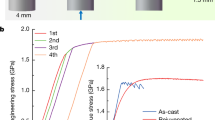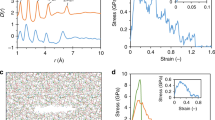Abstract
The selection and design of modern high-performance structural engineering materials is driven by optimizing combinations of mechanical properties such as strength, ductility, toughness, elasticity and requirements for predictable and graceful (non-catastrophic) failure in service1. Highly processable bulk metallic glasses (BMGs) are a new class of engineering materials and have attracted significant technological interest2,3,4,5,6. Although many BMGs exhibit high strength and show substantial fracture toughness, they lack ductility and fail in an apparently brittle manner in unconstrained loading geometries7. For instance, some BMGs exhibit significant plastic deformation in compression or bending tests, but all exhibit negligible plasticity (<0.5% strain) in uniaxial tension. To overcome brittle failure in tension, BMG–matrix composites have been introduced8,9. The inhomogeneous microstructure with isolated dendrites in a BMG matrix stabilizes the glass against the catastrophic failure associated with unlimited extension of a shear band and results in enhanced global plasticity and more graceful failure. Tensile strengths of ∼1 GPa, tensile ductility of ∼2–3 per cent9, and an enhanced mode I fracture toughness of K1C ≈ 40 MPa m1/2 were reported8,9. Building on this approach, we have developed ‘designed composites’ by matching fundamental mechanical and microstructural length scales. Here, we report titanium–zirconium-based BMG composites with room-temperature tensile ductility exceeding 10 per cent, yield strengths of 1.2–1.5 GPa, K1C up to ∼170 MPa m1/2, and fracture energies for crack propagation as high as G1C ≈ 340 kJ m-2. The K1C and G1C values equal or surpass those achievable in the toughest titanium or steel alloys, placing BMG composites among the toughest known materials.
This is a preview of subscription content, access via your institution
Access options
Subscribe to this journal
Receive 51 print issues and online access
$199.00 per year
only $3.90 per issue
Buy this article
- Purchase on Springer Link
- Instant access to full article PDF
Prices may be subject to local taxes which are calculated during checkout




Similar content being viewed by others
References
Ashby, M. F. Materials Selection in Mechanical Design Ch. 6 (Pergamon, Oxford, 1992)
Peker, A. & Johnson, W. L. A highly processable metallic glass: Zr41. 2Ti13. 8Cu12. 5Ni10. 0Be22. 5 . Appl. Phys. Lett. 63, 2342–2344 (1993)
Johnson, W. L. Bulk glass-forming metallic alloys: science and technology. MRS Bull. 24, 42–56 (1999)
Ashby, M. F. & Greer, A. L. Metallic glasses as structural materials. Scr. Mater. 54, 321–326 (2006)
Salimon, A. I. et al. Bulk metallic glasses: what are they good for? Mater. Sci. Eng. A 375, 385–388, (2004)
Greer, A. L. Metallic glasses. Science 267, 1947–1953 (1995)
Rao, X. et al. Preparation and mechanical properties of a new Zr-Al-Ti-Cu-Ni-Be bulk metallic glass. Mater. Lett. 50, 279–283 (2001)
Hays, C. C., Kim, C. P. & Johnson, W. L. Microstructure controlled shear band pattern formation and enhanced plasticity of bulk metallic glasses containing in situ formed ductile phase dendrite dispersions. Phys. Rev. Lett. 84, 2901–2904 (2000)
Szuecs, F., Kim, C. P. & Johnson, W. L. Mechanical properties of Zr56. 2Ti13. 8Nb5. 0Cu6. 9Ni5. 6Be12. 5 ductile phase reinforced bulk metallic glass composite. Acta Mater. 49, 1507–1513 (2001)
Liu, Y. H. et al. Super plastic bulk metallic glasses at room temperature. Science 315, 1385–1388 (2007)
Hofmann, D. C., Duan, G. & Johnson, W. L. TEM study of structural evolution in a copper mold cast Cu46Zr54 bulk metallic glass. Scr. Mater. 54, 1117–1122 (2006)
Fan, C. & Inoue, A. Ductility of bulk nanocrystalline composites and metallic glasses at room temperature. Appl. Phys. Lett. 77, 46–48 (2000)
Eckert, J. et al. Structural bulk metallic glasses with different length-scale of constituent phases. Intermetallics 10, 1183–1190 (2002)
He, G., Löser, W. & Eckert, J. Microstructure and mechanical properties of the Zr66. 4Cu10. 5Ni8. 7Al8Ta6. 4 metallic glass-forming alloy. Scr. Mater. 48, 1531–1536 (2003)
Lee, M. H. et al. Mechanical behavior of Ni-based metallic glass matrix composites deformed by cold rolling. Mater. Lett. 58, 3312–3315 (2004)
Lee, M. H. et al. A development of Ni-based alloys with enhanced plasticity. Intermetallics 12, 1133–1137 (2004)
Das, J. et al. “Work-hardenable” ductile bulk metallic glass. Phys. Rev. Lett. 94, 205501 (2005)
Yao, K. F. et al. Superductile bulk metallic glass. Appl. Phys. Lett. 88, 122106 (2006)
Eckert, J. et al. High strength ductile Cu-base metallic glass. Intermetallics 14, 876–881 (2006)
Chen, M. et al. Extraordinary plasticity of ductile bulk metallic glasses. Phys. Rev. Lett. 96, 245502 (2006)
Lee, S. Y. et al. Pseudo-binary phase diagram for Zr-based in-situ beta phase composites. J. Mater. Res. 22, 538–543 (2007)
Conner, R. D. et al. Shear bands and cracking of metallic glass plates in bending. J. Appl. Phys. 94, 904–911 (2003)
Ravichandran, G. & Molinari, A. Analysis of shear banding in metallic glasses under bending. Acta Mater. 53, 4087–4095 (2005)
Conner, R. D. et al. Shear band spacing under bending of Zr-based metallic glass plates. Acta Mater. 52, 2429–2434 (2004)
Myers, M. A. Mechanical Metallurgy: Principles and Applications (Prentice Hall, Englewood Cliffs, New Jersey, 1984)
Lewandowski, J. J., Wang, W. H. & Greer, A. L. Intrinsic plasticity or brittleness of metallic glasses. Phil. Mag. Lett. 85, 77–87 (2005)
Schroers, J. & Johnson, W. L. Ductile bulk metallic glasses. Phys. Rev. Lett. 93, 255506 (2004)
Liang, J. Z. & Li, R. K. Y. Rubber toughening in polypropylene: a review. J. Appl. Polym. Sci. 77, 409–417 (2000)
Lee, M. L. et al. Effect of a controlled volume fraction of dendritic phases on the tensile and compressive ductility in La-based metallic glass matrix composites. Acta Mater. 52, 4121–4131 (2004)
Acknowledgements
We acknowledge the Office of Naval Research for partial support of this work. D.C.H. acknowledges financial support from the Department of Defense through the NDSEG fellowship programme. This work benefited from the use of the Caltech Kavli Nanoscience Institute and the Mat. Sci. TEM facilities supported by the MRSEC Program of the National Science Foundation. We thank C. Garland for assistance with the TEM work. We also thank S. Y. Lee, K. S. Vecchio, C. P. Kim and C. E. Hofmann for their comments and advice.
Author information
Authors and Affiliations
Corresponding author
Supplementary information
Supplementary Figures
This file contains Supplementary Figures 1-10 with Legends supporting the claims reported in the manuscript. The Supplementary Figures include a schematic illustration of the main findings, SEM micrographs, DSC scans, optical images, XRD scans, and shear modulus plots. (PDF 1230 kb)
Rights and permissions
About this article
Cite this article
Hofmann, D., Suh, JY., Wiest, A. et al. Designing metallic glass matrix composites with high toughness and tensile ductility. Nature 451, 1085–1089 (2008). https://doi.org/10.1038/nature06598
Received:
Accepted:
Issue Date:
DOI: https://doi.org/10.1038/nature06598
This article is cited by
-
Elemental partitioning-mediated crystalline-to-amorphous phase transformation under quasi-static deformation
Nature Communications (2024)
-
Corrosion Behavior of In-situ Zr-Based Metallic Glass Matrix Composites in Aqueous Environments
Journal of Materials Engineering and Performance (2024)
-
Phase patterning of metallic glasses through superfast quenching of ion irradiation-induced thermal spikes
Nano Convergence (2023)
-
Non-affine atomic rearrangement of glasses through stress-induced structural anisotropy
Nature Physics (2023)
-
Toughening oxide glasses through paracrystallization
Nature Materials (2023)
Comments
By submitting a comment you agree to abide by our Terms and Community Guidelines. If you find something abusive or that does not comply with our terms or guidelines please flag it as inappropriate.



